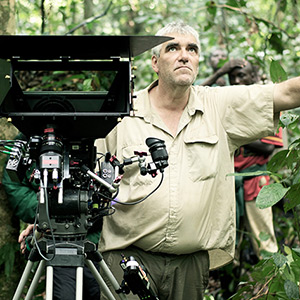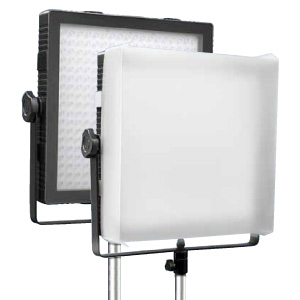 For the Last of the Great Apes project we needed a lightweight, portable, high output, rainproof, robust and quick to set lighting solution. A one kit does all solution for what we believe is the smallest 3D feature doc crew in the world. A three man camera department of DP stereographer and AC, taking 3D where is has never been before, into the heart of the jungles of the Congo, Tanzania, Borneo and Sumatera. After a lot of online research and then seeing the Dedo Felloni and at the Lemac stand at SMPTE2011 I was convinced.
For the Last of the Great Apes project we needed a lightweight, portable, high output, rainproof, robust and quick to set lighting solution. A one kit does all solution for what we believe is the smallest 3D feature doc crew in the world. A three man camera department of DP stereographer and AC, taking 3D where is has never been before, into the heart of the jungles of the Congo, Tanzania, Borneo and Sumatera. After a lot of online research and then seeing the Dedo Felloni and at the Lemac stand at SMPTE2011 I was convinced.
The high CRI means class leading colour rendition, they are lightweight, use less power and are less expensive than other competitors units. This ticked boxes but also the clincher was they are rainproof. Numbers suggested we would get about 3 hrs. light out of a single IDX HL9S, important if you need to carry them into remote locations. Also the ability to be able to dim them from hero to zero without changing color temperature is great.

So we bought one 15 deg hi brite daylight, one 30 deg hi brite daylight and one 50 deg hi bright daylight and finally one 50 deg hi brite bi colour. These were housed in two 1600 pelican cases with suitable foam cutouts. All in all, a neat piece of kit and each case only weighed in at 11kgs.
The Last of the Great Apes is a 3D filming project capturing the world’s primates in their natural habitats, documenting their plight and the deadly dangers threatening their survival. From the peaks if the Virunga volcanoes in the Democratic Republic of Congo to the dense lowland jungles of the Republic of Congo, to the shores of Lake Tanganyika, the swampy rivers of Borneo and the rainforests of Sumatera
So where did we take them and what did they get used for. We they were used for everything you could imagine. From lights to film by of course, to the best worklight you have ever used especially as compared to a headtorch in a mud hut in a jungle village.
They first came out of the box morning day 2 at our first shoot location. We needed to cover baby Bonobo chimps being bathed inside their dormitory. Now to paint picture we were shooting on SI 2K cameras, on a 3Ality Beamsplitter rig. These cameras are rated at ISO 250 daylight. Lose a stop for the beamsplitter and you are looking at a basic ISO 125. Back to the numbers found in the days of film. So plenty of light was essential. Add to this that the washing room was all white tiles, African faces and black furred bonobos, with water going everywhere and random action, oh and the wash tub was also in a corner of the room. Hard just became very hard. Two very reflective surfaces at ninety degrees to each other and everyone facing a wall. The life of a doco guy is never easy. So how did we do it. The 15 deg was rigged above the wash trough from the roof with some black wrap cutting the white walls, the 30 deg punched through the barred door as a back / rim light kicker that also kept of the walls, the 50deg with its diffuser as a gentle soft fill, angled to not catch reflections on the tiles but enough to see faces and detail without cooking up the white tiles. The result, a nice little scene with great shadow detail, no nasty hotspots/highlights on the tiles and no worries about water splashing everywhere. Oh and the Bonobos being washed were cute.
The Dedo Felloni lights also gave great service for on location, (in our case jungle) interviews as well. Every camera person know the sinking feeling as you get 2 mins into the interview and the lone cloud in the sky goes over the sun and there goes that nice little highlight kick you lined up so carefully. So in that scenario the Dedo Feloni kit came out again. Sure the sun is in just the right place but it never hurts to add a backup, so when the sun goes in the highlight level drops but only a by a stop. No problem like a safety net the LED panel takes over and keeps up the exposure. With the 50 degree unit giving a diffuse fill to give a natural soft flush to the faces you are on a winner. No stopping for the light and what is better a lit interview in the rainforest that does not look lit at all regardless of the sun coming and going.
And so the pattern was established, in the 16 weeks of shooting these lights got a major work out. They had enough grunt to be used outdoors as a fill or kick in sunlight, to set a base level when the sun might come and go. To be subtle enough for close intimate wrap around lighting and with grunt enough to fill a space in full shade looking out to full sun. While the lighting is not perfect as compared to what can be done with a full lighting truck, what we achieved with our four Dedo felloni heads, diffusers, a roll of black wrap, four lightweight stands at all up weight under 30kgs with just a 3 man crew is really nice and I believe when people view this film they will never know the lighting was just our Dedo Felloni units.
Mark Lamble ACS
DP Last of the Great Apes.
http://thelastofthegreatapes.com